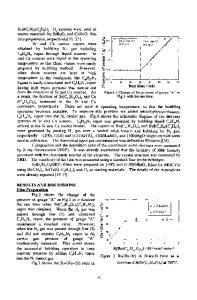From Hybrid Films to Mesoorganized Multi-metal-oxide Nanocrystalline Films (M 3 NF), preparation and characterization.
- PDF / 4,233,926 Bytes
- 12 Pages / 612 x 792 pts (letter) Page_size
- 19 Downloads / 310 Views
EE2.2.1
From Hybrid Films to Mesoorganized Multi-metal-oxide Nanocrystalline Films (M3NF), preparation and characterization. Cédric Boissièrea, David Grossoa, Bernt Smarslyb, Torsten Brezesinskib, Sophie Lepoutrea, Lionel Nicolea, J.C. Valle Marcosa, Marcus Antoniettib and Clément Sancheza*. a
Chimie de la Matière Condensée, UPMC- CNRS UMR 7574, 4 place Jussieu, 75252 Paris Cedex 05, France b Max Planck Institute of Colloids and Interfaces, Research Campus Golm,D-14424 Potsdam, Germany ABSTRACT High quality and reproducible thin silica and non-silica mesoporous films were obtained with mono-oriented organised mesoporosity, fitting various symmetry groups (i.e. p6m, Pm3n, Im3m, …). The Evaporation Induced Self Assembly (EISA) mechanism of structuration was studied through in-situ time-resolved SAXS, interferometry and spectroscopic ellipsometry investigations during dip-coating. A Modulable Steady State (MSS) was found during which the system is in quasi-equilibrium with its environment and during which the final structure is formed. The corresponding Self-Assembly mechanism was found to be governed by a competition between evaporation, micellization and condensation that depend on various critical chemical and processing parameters the influence of which have been summarized into directly usable phase diagrams. Calcined SiO2 and TiO2 mesoporous films structure (pore size and anisotropy, porous volume and surface) and mechanical properties (young modulus) were investigated by UVVisible spectroscopic ellipsometry. Finally, thanks to a specially designed block copolymer, one further step was accomplished by achieving the dip coating and controlled nano-crystallisation of various metallic and multi-metal-oxides films (M3NF) of composition CoxTi(1-x)O(2-x) with ilmenite or doped Anatase structure, and SrTiO3 and MgTa2O6 with perovskite structure. Attending the well known magnetic, dielectric and catalytic properties of these structures, M3NF are highly compatible with high technology applications in microelectronic, energy transfer devices, spintronic, nano-mechanical adjustments, data storage, oxide fuel cells … INTRODUCTION Several types of self-assembled mesostructured materials have been synthesized in recent years [1] and interesting perspectives have been opened to fabricate different optical, [2,3] electronic, [4] and sensing devices. [5] Mesostructured films are particularly appealing for their potential applications in microelectronics and photonics, even if they are more difficult to prepare with respect to powders because high control of self-assembling is required. Recent works have clearly outlined the relationships between the synthesis conditions and the final mesophase.[6] A good control of pore size, orientation, and connectivity has been achieved and lamellar, bidimensional (2D) hexagonal, three dimensional (3D) hexagonal, or cubic mesophases are commonly obtained. Extensive studies have clarified a great part of the processes that are beneath the Evaporation-Induced Self Assembling (EISA) [7] of oxid
Data Loading...










